Relias Dysrhythmia Basic Guías de estudio, Notas de estudios & Resúmenes
¿Buscas las mejores guías de estudio, notas de estudio y resúmenes para Relias Dysrhythmia Basic? En esta página encontrarás 413 documentos de estudio para Relias Dysrhythmia Basic.
Página 3 fuera de 413 resultados
Ordenador por
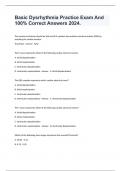
-
Basic Dysrhythmia Practice Exam And 100% Correct Answers 2024.
- Examen • 4 páginas • 2024
-
Disponible en paquete
-
- 9,55 €
- + aprende más y mejor
The monitor technician should be able to tell if a patient has pulseless electrical activity (PEA) by watching the cardiac monitor. True/False - Answer False The P wave represents which of the following cardiac electrical events. A. Atrial depolarization B. Atrial repolarization C. Ventricular depolarization D. Ventricular repolarization - Answer A. Atrial Depolarization The QRS complex represents which cardiac electrical event? A. Atrial depolarization B. Atrial repolarizat...
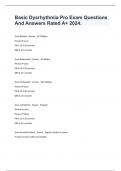
-
Basic Dysrhythmia Pro Exam Questions And Answers Rated A+ 2024.
- Examen • 6 páginas • 2024
-
Disponible en paquete
-
- 9,55 €
- + aprende más y mejor
Sinus Rhythm - Answer 60-100bpm Present P-wave PRI 0.12-0.20 seconds QRS 0.12> seconds Sinus Bradycardia - Answer 40-60bpm Present P-wave PRI 0.12-0.20 seconds QRS 0.12> seconds Sinus Tachycardia - Answer 100-160bpm Present P-wave PRI 0.12-0.20 seconds QRS 0.12> seconds Sinus arrhythmia - Answer Irregular Normal or slow Present P-Wave PRI 0.12-0.20 seconds QRS 0.12> seconds Sinus Arrest/Exit block - Answer Regular rhythm w/ pause P-wave not seen un...
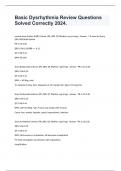
-
Basic Dysrhythmia Review Questions Solved Correctly 2024.
- Examen • 10 páginas • 2024
-
Disponible en paquete
-
- 9,55 €
- + aprende más y mejor
normal sinus rhythm (NSR) Criteria: (PR, QRS, QT, Rhythm: reg or irreg) - Answer 1 P-wave for Every QRS, REGULAR rhythm PR: 0.12-0.20 QRS: 0.06-0.10 BBB = > 0.12 QT: 0.36-0.44 BPM: 60-100 Sinus Bradycardia Criteria: (PR, QRS, QT, Rhythm: reg/irreg) - Answer PR: 0.12-0.20 QRS: 0.06-0.10 QT: 0.36-0.44 BPM: < 60 (Reg. rate) Tx: Atropine 0.5mg, Pace, Dopamine 2-10 mcg/kg/min, Epie 2-10 mcg/min Sinus Tachycardia Criteria: (PR, QRS, QT, Rhythm: reg/irreg) - Answer PR: 0.12-0....
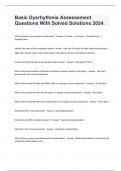
-
Basic Dysrhythmia Assessement Questions With Solved Solutions 2024.
- Examen • 10 páginas • 2024
-
Disponible en paquete
-
- 9,65 €
- + aprende más y mejor
What is the flow of conduction in the heart? - Answer SA Node --> AV Node --> Bundle of His --> Purkinje fibers Identify the parts of the conduction system - Answer Left side: SA node, AV node, Right bundle branch Right side: Bundle of His, Left bundle branch, Left anterior division, Left posterior division In which AV block should we use Atropine with caution? - Answer 2nd degree TYPE 2 What is the special quality of the heart in relation to other muscles in the body? -...
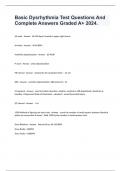
-
Basic Dysrhythmia Test Questions And Complete Answers Graded A+ 2024.
- Examen • 5 páginas • 2024
-
Disponible en paquete
-
- 9,55 €
- + aprende más y mejor
SA node - Answer 60-100 bpm/ located in upper right atrium Av Node - Answer 40-60 BPM Ventiricle depolarization - Answer 20-40 BP P wave - Answer atrial depolarization PR interval - Answer represents AV conduction time-- .12-.20 QRS - Answer ventricle depolarization; QRS interval=<.12 ST segment - Answer used to further describe a rhythm: ventricle is still depolarized, should be at baseline -if depressed think of Mischemia , elevated = acute Myocardial injury ...
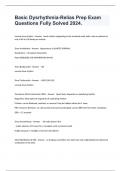
-
Basic Dysrhythmia-Relias Prep Exam Questions Fully Solved 2024.
- Examen • 4 páginas • 2024
-
Disponible en paquete
-
- 9,55 €
- + aprende más y mejor
normal sinus rhythm - Answer heart rhythm originating in the sinoatrial node with a rate in patients at rest of 60 to 100 beats per minute Sinus Arrhythmia - Answer Appearance is ALMOST NORMAL: Respiratory - Circulatory interaction Rate INCREASES with INSPIRATION (IN=IN) Sinus Bradycardia - Answer <60 normal sinus rhythm Sinus Tachycardia - Answer >100 (100-150) normal sinus rhythm Premature Atrial Contraction (PAC) - Answer Heart Rate: Depends on underlying rhyth...
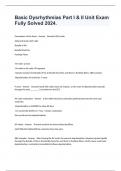
-
Basic Dysrhythmias Part I & II Unit Exam Fully Solved 2024.
- Examen • 22 páginas • 2024
-
Disponible en paquete
-
- 9,74 €
- + aprende más y mejor
Pacemakers of the Heart - Answer Sinoatrial (SA) node Atrioventricular (AV) node Bundle of His Bundle Branches Purkinje Fibers -SA node: p wave -SA node to AV node: PR segment -Impulse travels from Bundle of His to Bundle branches and then to Purkinje fibers: QRS complex -Repolarization of ventricles: T wave P wave - Answer sinoatrial node (SA node) starts an impulse, as the wave of depolarization spreads through the atria, _______ is inscribed on the ECG AV node conduction...
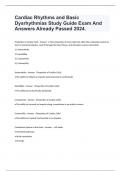
-
Cardiac Rhythms and Basic Dysrhythmias Study Guide Exam And Answers Already Passed 2024.
- Examen • 7 páginas • 2024
-
Disponible en paquete
-
- 9,55 €
- + aprende más y mejor
Properties of Cardiac Cells - Answer • Four properties of heart cells that allow the conduction system to start an electrical impulse, send it through the heart tissue, and stimulate muscle contraction: 1.) Automaticity 2.) Excitability 3.) Conductivity 4.) Contractility Automaticity - Answer (Properties of Cardiac Cells) • The ability to initiate an impulse spontaneously & continuously Excitability - Answer (Properties of Cardiac Cells) • The ability to be electrically s...
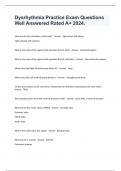
-
Dysrhythmia Practice Exam Questions Well Answered Rated A+ 2024.
- Examen • 12 páginas • 2024
-
Disponible en paquete
-
- 9,65 €
- + aprende más y mejor
What are the four chambers of the heart? - Answer right atrium, left atrium right ventricle, left ventricle What is the name of the septum that separates the R/L atria? - Answer interatrial septum What is the name of the septum that separates the R/L ventricles? - Answer interventricular septum Where does the Right Ventricle pump blood to? - Answer lungs Where does the Left Ventricle pump blood to? - Answer throughout the body T/F the atria contract at the same time, fo...
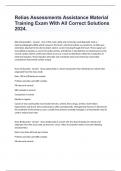
-
Relias Assessments Assistance Material Training Exam With All Correct Solutions 2024.
- Examen • 6 páginas • 2024
-
Disponible en paquete
-
- 9,55 €
- + aprende más y mejor
EKG interpretation - Answer One of the most useful and commonly used diagnostic tools is electrocardiography (EKG) which measures the heart's electrical activity as waveforms. An EKG uses electrodes attached to the skin to detect electric current moving through the heart. These signals are transmitted to produce a record of cardiac activity. Arrhythmia or dysrhythmia are disturbances in the normal cardiac rhythm of the heart which occurs as a result of alterations within the conduction of ele...

5,99 euros por el resumen de tu libro de texto multiplicado por 100 compañeros... Haz cuentas: ¡eso es mucho dinero! No seas ladrón de tu propia cartera y empieza ya a subir el tuyo. Descubre todo sobre cómo ganar en Stuvia


